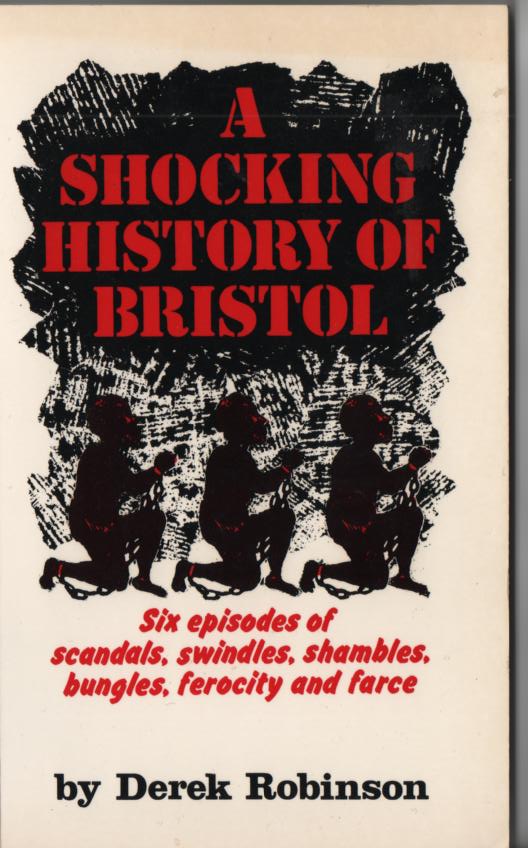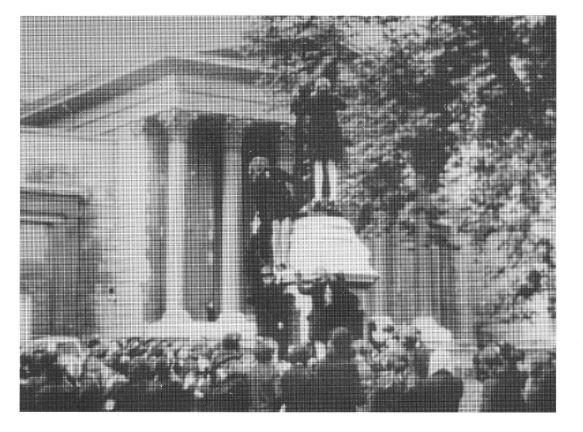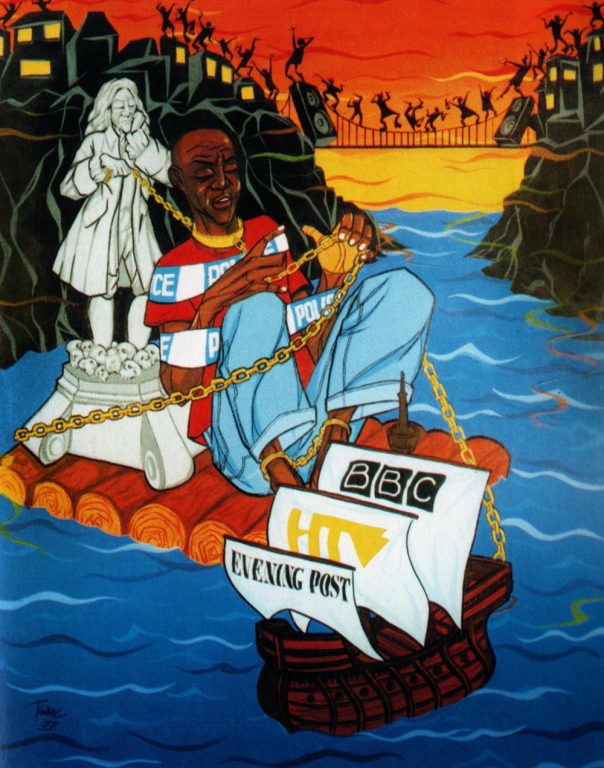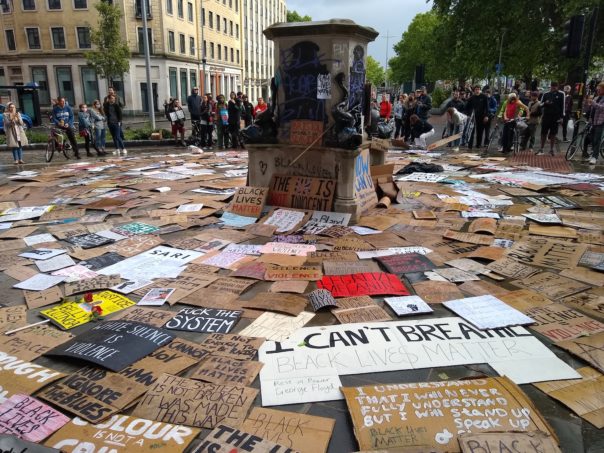Introduction
During the furore about the renaming of the Colston Hall in 2017 a number of angry letter-writers to the Bristol Post claimed that the recent protests over Edward Colston were merely a ‘flash in the pan’ and a product of ‘woke’, faddist politics propagated by people from outside Bristol. This attempt to reduce the actions of groups and movements like Countering Colston and Black Lives Matter to a particular historical moment whilst the great weight of a supposed ‘tradition’, such as the ‘cult of Colston’, prevails is a common tactic in these types of disputes over history.
As we have learned in exploring and exposing several myths around Edward Colston, it is worth checking the facts before accepting what his defenders claimed was true. So the blanket assertion that dissent and protest over Colston’s iconic status in the city was merely a passing fad of millennials that came from ‘outside’, required investigation. The research document below is the summary of a survey of around 80 incidents of dissent and protest concerning Edward Colston stretching out over the last century, before his statue was pulled down by Black Lives Matter protestors in June 2020. The references and more details of the incidents are given in the Sources section. This timeline is certainly unfinished, though some interesting and unexpected periods of dissent have been revealed.
Trouble in the 1920s and 1930s
The most striking feature of the timeline is not just the large number and diversity of incidents of dissent and protest but the fact that there was significant opposition to the half-truths of the commemoration ceremonies of Edward Colston nearly a century ago. The first sign of dissent appears in the form of a critical biography of Edward Colston penned by the reforming vicar Henry Wilkins in 1920.[1] Wilkins’ book documented from primary sources Edward Colston’s leading involvement in the seventeenth century transatlantic slave-trade through the Royal African Company. It also swept away a number of myths about Colston and demonstrated that his feted philanthropy was deeply selective due to his active religious and political bigotry, and thus excluded large numbers of Bristolians.
The impact of this biography and a supplement he published in 1925 is demonstrated in an editorial in the Western Daily Press which supported Wilkins’ argument that that Colston Day excluded many other Bristolians “deserving of being remembered” and suggested it:
shall be still more radically altered so that instead of being devoted to singing the praises of one illustrious citizen it shall be used for paying tribute to many who have found a place in local history.[2]
Regardless of this half-way house position concerning the annual celebrations clearly Wilkins’ revelations about Colston’s involvement in the transatlantic slave trade were now being discussed as a potential ‘problem’ for his iconic status. The effect of this debate in the city is reflected in the Church of England’s repeated defence of his involvement in slavery in sermons given on Colston Day celebrations in the Cathedral. In November 1927 it was reported in the Western Daily Press that the Dean of Bristol had:
laid special emphasis upon the necessity of placing Colston’s connection with the slave-trade and money lending against the historical background of his day.[3]
Three years later, in a rather more desperate statement from the pulpit, the Rev. G. W. L. Wynne refuted the claim that Edward Colston had been tarnished by his association with the slave-trade. Instead he stated that:
everyone who could made money from the slave-trade in those days, and anyone who did not was regarded as a freak.[4]
In addition to putting down those who were against slavery by describing them in a rather unchristian manner as ‘freaks’ this is an early example of the spurious ‘we were all at it’ defence, so beloved of the Society of Merchant Venturers and their supporters in the twenty-first century.[5]
Nevertheless the criticism of Colston appears to have continued into the 1930s. In November 1936 the Western Daily Press ran an editorial article by Eric Buxton a member of the staff at the paper which acknowledged Edward Colston’s religious and political bigotry and his involvement in the slave-trade but argued he was as “human as [the] rest of us”. Buxton did concede that:
Experience suggests where a public man has a black mark on his public character, it is hushed up and passed over in silence when he is being praised – not brought up and exposed for what it is worth.[6]
Several letters to the paper followed this article discussing Edward Colston’s involvement in the slave trade. On the 301st anniversary of Colston’s birth in November 1937 the Church was once again compelled to make a statement in the Cathedral on Colston Day when Canon Fitzgerald stated in his sermon that:
if he [Edward Colston] did make much of his money by the slave-trade it was unfair to blame him for not being in advance of his time.[7]
These pieces of evidence demonstrate that Edward Colston’s involvement in the transatlantic slave trade and his political and religious bigotry were certainly known by a significant section of the clergy in the 1920s and 1930s, had penetrated into the wider population via the media and that there was an ongoing debate requiring repeated public defences of Colston by the Church of England. Clearly Rev. Henry Wilkins’ book had opened up a right can of worms.
One other surprising observation can also be made. That is, there seems to have been a greater awareness of the problematic history of Colston in the Bristol Diocese in the 1920s and 1930s than in the late twentieth and early twenty-first centuries. In the earlier period at least Colston’s involvement in slavery was being acknowledged by the Church of England. The ignorance of the latter period was summed up by the clumsy (and incendiary) words of Bishop of Bristol Mike Hill in November 2014 when he stated to an audience of school pupils on Charter Day in the Cathedral:
I think he [Edward Colston] was a man who lived a life of significance, and I’ve found there may be still some speculation however, on some of the circumstances around his business roots right here [in Bristol]. It is speculation.[8]
Post-war dissent
The first evidence of dissent in the post-war period that we have been able to find appears in a comment piece in the Bristol Evening Post in 1961 where, under the pseudonym ‘Neptune’, the writer stated:
Not all his [Colston’s] personal qualities were wholly admirable, I read that he was obstinate, short-tempered, and intolerant, with a narrowness of outlook that bordered on bigotry in religious and political matters…Then there was the fact that much of his wealth came from the slave trade, his sympathies were narrow.[9]
It appears that this kind of criticism of the ‘great men’ of Bristol which exposed their links to slavery was becoming prevalent once again. In an angry and polemical deviation in his 1963 pamphlet entitled Bristol & the Slave Trade Prof. Charles MacInnes of Bristol University stated:
In the course of the eighteenth-century mayors of Bristol, sheriffs, aldermen, town councillors, Members of Parliament, the Society of Merchant Venturers and, indeed, men of the highest repute in the place were engaged in this traffic [the slave trade]. These were not wicked men but pillars of society in their own time and there seems to be little justification for that macabre self satisfaction which some Bristolians appear to derive from the recollection of the presumed moral depravity of their forbears. If these men are to be judged then it should be by the moral standards of the time in which they lived. Since the nation as a whole at that time condoned their activities and applauded them for their enterprise, there would appear to be no special reason why they should be selected for particular condemnation. Many of them honestly believed that though negroes [sic] looked like men they were not really human.[10]
We will leave MacInnes’ more spurious claims for criticism elsewhere[11] but what is clear is that there were a number of ‘Bristolians’ (including Neptune) taking “macabre self satisfaction” in exposing the links between the “pillars of society” and slavery in the 1960s.

After the publication of Derek Robinson’s A Shocking History of Bristol in 1973, which pulled no punches in exposing Edward Colston’s involvement in transatlantic slavery, the cat was out of the bag once again.[12] Wilkins’ 1920 biography may have only been read amongst the clergy and other limited circles but Robinson’s populist history book captured the imagination and was widely read in Bristol by young and old alike. As a result, in the early 1980s historians and academics began to make forays into the public domain to criticise the continuing celebration of the sanitised Edward Colston. In 1980 at the Southey Lecture, Bristol University Professor of History Patrick McGrath stated:
he [Edward Colston] only gave his money away so he would be remembered … I object to him being worshipped just because he gave his money away … that doesn’t make him a good man.[13]
In the subsequent furore in the press McGrath was accused of doing a “hatchet job and a character assassination” on Edward Colston. A year later in a feature article entitled ‘The secret life of Mr Bountiful’ in the Bristol Evening Post historian David Foot explicitly criticised Edward Colston and his sycophantic biographers when he claimed:
Whatever the doting contemporary history book writers might imply his generosity should not obscure the shadier facets of his character. He grew rich and fat on the slave-trade conveniently ignoring it or even condoning it like many leading churchmen of his day.[14]

Whilst some historians broke cover in the 1980s, the 1990s were to see a diversification of dissent from the literary to artistic protest. Notable artistic interventions included ex-Colston’s Girl’s school student Carole Drake’s installation Commemoration Day, part of the Trophies of Empire exhibition at the Arnolfini in 1992, the boycott of the ‘Colston Hall’ launched by the internationally famous Bristol band Massive Attack, the painting Sold Down the River by Bristolian artist Tony Forbes and various installations at the Colston statue.[15] When the statue was graffitied in 1998 it made national news.[16] All of these interventions, allied with protests at the launching of the replica ship the Matthew in 1995, at the Festival of the Sea the following year and the 1999 exhibition A Respectable Trade? Bristol & Transatlantic Slavery helped bring the issue of slavery and Edward Colston into the public domain in the twenty-first century.[17]

And the Colston Hall?
The bicentenary of the abolition of the British slave trade in 2007 was a contentious period in Bristol. Debates raged in Bristol about which historical narratives were going to be represented by the ‘official’ celebrations, whether ‘Bristol’ or Bristol Institutions (such as the Society of Merchant Venturers) should apologise for slavery and what the legacy of the bicentenary would be.[18] One ‘elephant in the room’ was the fact that the official celebrations were using the Colston Hall as a venue for events, despite the fact that it was being boycotted by many Bristolians. This led to protests in the autumn of 2007 outside the Hall by the group ‘Artists for a name change’. Performers at the events, many of whom weren’t from Bristol and thus had no idea of who Colston was, echoed the renaming demand of the protestors to the audiences to rapturous applause.[19]
Calls for the renaming the Colston Hall were not confined to the protests, in fact there had been repeated interventions over several years. In 1998 after plans for refurbishment of the Colston Hall were announced Massive Attack band member 3D reasserted their boycott and stated:
it should be renamed as a building and not continue to celebrate the name of someone who was involved in the slave trade.[20]
In 2003, a major redevelopment of the Colston Hall led to calls for a name change in the local media and in March 2007, several months before the Bicentenary protests civil rights campaigner Paul Stephenson renewed these calls. This led to articles in the national press exposing Edward Colston’s involvement in the transatlantic slave trade.[21] In April 2011 the new management body for the Colston Hall, the Bristol Music Trust (BMT) recognising that many Bristolians boycotted the venue announced it could be renamed “if that’s what people want”. Another debate ensued in the local media, though in August the BMT rejected any change as “tokenistic”, leading Paul Stephenson to state it was another “lost opportunity”.[22]
Protests outside the Colston Hall by the Countering Colston group in December 2016 and in early 2017 during the 150th anniversary of the Colston Hall were complimented by the demands for a name change from campaigners within the BMT. This time the opportunity was seized and in April the BMT decided unanimously to change the name. BMT Chief Executive Louise Mitchell made it clear after claims that the decision had been motivated for financial reasons, that it had been “entirely moral” rather than financial and referred to Edward Colston as a “toxic brand”.[23]

Conclusion
Clearly even the incomplete evidence presented here demonstrates a century-long history of dissent, protest and direct action emanating from the exposure of Edward Colston’s involvement in slavery and the exploding of myths concerning his philanthropy. Much of the credit for this lies with the Rev. Henry Wilkins and his detailed and critical biography of Edward Colston published in 1920. There have clearly been periods where the debate over the commemoration, celebration and memorialisation of the iconic and leading slave trader Edward Colston has waned, but it never disappeared. Instead, particularly since the 1990s, dissent and protest has come in inexorable and intensifying cycles every few years.
The idea that the toppling of Colston’s statue last year or the changing of the name of the Colston Hall in 2017 were the product of ‘woke’ faddism denies the actions of many Bristolians who, over many decades, have sought to tell the truth about Edward Colston and challenge his ‘cult’. These people range from those who crept through the darkness to mark his statue with the words “slave trader” to those who burrowed though the archives to get the facts straight. We salute them all.
Postscript: What is missing?
As noted at the start of this article this timeline of dissent and protest is incomplete. The main reason for this has been the difficulty in accessing primary sources in archives due to the Covid19 restrictions in place in 2020-2021. There are two particular periods which need further research.
The first is the 1920s-1930s, where although we have evidence of the reaction of the Church of England and the media to criticism of Edward Colston, we do not have the sources of that criticism, other than the works and letters of Rev. Henry Wilkins. It is possible that anti-colonial and anti-nationalist organisations on the left such as the Independent Labour Party or the Communist Party may have been responsible for some of the criticism, or perhaps non-conformist religious groups that have a long history of opposition to slavery such as the Quakers.
The second period is post-war between 1945 and 1973 (the publishing of Derek Robinson’s book). We have a few critical letters and the vociferous response from Prof. MacInnes which suggest there was wider criticism of the ‘Cult of Colston’ taking place, the question is where?
We have yet to discover answers to these historical questions, and this is where you, the reader, come in. Most of the research to compile this timeline was a collective undertaking, using our group memories as a way of remembering and pointing to sources. If you have information or research which relates or adds to the timeline, please get in touch with BRHG.
Acknowledgements
The following people compiled, checked and/or provided sources for this timeline: Roger Ball, Mark Steeds, Ros Martin, Christine Townsend, Dawn Dyer, Eugene Byrne, Robin Askew, Maureen Ball and Tim Beasley.
Notes
[1] Wilkins, H. J. Edward Colston (1636-1721 A.D.), A Chronological Account of His Life and Work Together with an Account of the Colston Societies and Memorials in Bristol. Bristol: Arrowsmith, 1920. Wilkins (1865-1941) arrived in Bristol in 1889 to take up the post of curate in St Jude’s Church one of the poorest inner-city areas, racked with poverty and social unrest. He may have come from a wealthy background, but he certainly was working at the proverbial coal face in Bristol. Wilkins was a Liberal party member and authored a tract on housing the poor in 1893 which some commentators have argued influenced the development of municipal housing in the city in the twentieth century. In 1900 Wilkins went on to become the Vicar of Redland and Westbury where he remained until his death during the Second World War. Coates, R. Wilkins of Westbury & Redland: the life and writings of Rev Dr Henry John Wilkins (1865-1941). Bristol: ALHA Books No. 24, 2017.
[2] “Then and Now” Western Daily Press 3 November 1925.
[3] “Colston Celebrations” Western Daily Press 15 November 1927.
[4] “Tributes to Bristol’s Great philanthropist” Western Daily Press 14 November 1930.
[5] See for example the statement made by D’Arcy Parkes on behalf of the Society of Merchant Venturers in Bristol Evening Post 28 November 2006.
[6] “What Bristol Owes to Edward Colston” Western Daily Press 13 November 1936.
[7] “301st Anniversary of Colston’s Birth” Western Daily Press 15 November 1937.
[8] “Bristol bishop says slave trader remarks ‘misinterpreted’” BBC News Bristol 12 November 2014. Accessed March 2018. http://www.bbc.co.uk/news/uk-england-bristol-30016789; Brown, C. “Bishop defends views on slave trader” B24/7 November 12, 2014. Accessed March 2018. https://www.bristol247.com/news-and-features/news/bristol-bishop-defends-views-on-slave-trader/.
[9] Neptune, “There were two sides to Mr Colston” Bristol Evening Post 30 October 1961.
[10] MacInnes, C. M. Bristol and the Slave Trade. (Bristol: Bristol Branch of the Historical Association, 1963) p.9.
[11] See for example the response of Steeds and Ball in From Wulfstan to Colston: Severing the sinews of slavery in Bristol. (Bristol: BRHG, 2020) p. 262.
[12] Robinson, D. A Darker History of Bristol. (Bristol: Countryside Books, 2005). First published as A Shocking History of Bristol. (London: Abson Books, 1973).
[13] “‘Hatchet Job’ row erupts” Bristol Evening Post 6 June 1980.
[14] Foot, D. “The secret life of Mr Bountiful” Bristol Evening Post, 6 August 1981.
[15] Trophies of Empire (Liverpool: Bluecoat Gallery and Liverpool John Moores University 1994) pp. 41-42; Mitchell, J. Hall or nothing? Venue No. 424 21 August – 4 September 1998; Cavell, N. “Under Attack: Band snub Colston Hall because of city father’s slave links” Bristol Post 21 August 1998; Byrne, E. FLYERS 340/EB Tales from the River [supplied by email 9 March 2021].
[16] Wilkins, E. “Graffiti attack revives Bristol slavery row.” The Times 29 January, 1998.
[17] Steeds and Ball, From Wulfstan to Colston p. 266 and pp. 268-269.
[18] For more details see Steeds and Ball, From Wulfstan to Colston pp. 270-274.
[19] Steeds and Ball, From Wulfstan to Colston pp. 273-274.
[20] Mitchell, J. Hall or nothing? Venue No. 424 21 August – 4 September 1998; Cavell, N. “Under Attack: Band snub Colston Hall because of city father’s slave links” Bristol Post 21 August 1998.
[21] “Still A Slave to Political Correctness”, Western Daily Press 8 April 2003; “Colston row” – Western Daily Press 14 March 2007; “I have watched many a rock gig” – The Independent 31 March 2007; “We’re £32m short of a new Colston Hall” – Western Daily Press 3 July 2007.
[22] “If people want Colston name changed, then we’ll change it” Bristol Post, 1 April 2011; “Colston name is hall right” Bristol Post, 18 August 2011.
[23] Steeds and Ball, From Wulfstan to Colston p. 280; Yong, M., Cork, T. and Davies, N. “Colston Hall to be renamed for 2020 relaunch”. Bristol Post 26 April, 2017; Yong, M. “Colston Hall name change was a ‘moral decision’ not a financial one, as bosses gear up for backlash”. Bristol Post 27 April, 2017.

Sol Gamsu
Lovely piece, I’d like to cite it in an academic article I’m writing about (mostly private) schools’ ties to the slave trade and empire. Could you let me know who I should list as the author of the piece? Is it just all the authors of the timeline?